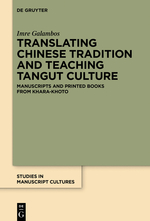SMC 6

Translating Chinese Tradition and Teaching Tangut Culture:
Manuscripts and Printed Books from Khara-Khoto
By Imre Galambos
This book is about Tangut translations of Chinese literary texts. Although most of the extant Tangut material comprises Buddhist texts, there are also many non-religious texts, which are mostly translations from Chinese. The central concern is how the Tanguts appropriated Chinese written culture through translation and what their reasons for this were. Of the seven chapters, the first three provide background information on the discovery of Tangut material, the emergence of the field of Tangut studies, and the history of the Tangut state. The following four chapters are devoted to different aspects of Tangut written culture and its connection with the Chinese tradition. The themes discussed here are the use of Chinese primers in Tangut education; the co-existence of manuscript and print; the question how faithful Tangut translators remained to the original texts or whether they at times adapted those to the needs of Tangut readership; the degree of translation consistency and the preservation of the intertextual elements of the original works. The book also intends to draw attention to the significant body of Chinese literature that exists in Tangut translation, especially since the originals of some of these texts are now lost.
Frontmatter, Acknowledgements
Contents
Introduction1
1 Ruins of a forgotten city 17
1.1 Kozlov’s first visit to Khara-khoto (1908)19
1.2 Kozlov’s second visit to Khara-khoto23
1.3 Discovery before the “first” discovery29
1.4 Aurel Stein’s 1914 visit to Khara-khoto 37
1.5 Subsequent exploration of Khara-khoto 43
1.6 The Dunhuang and Khara-khoto materials: Analogies and connections 47
2 Tangut studies: Emergence of a field53
2.1 Before the discovery of Khara-khoto 54
2.2 The discovery of Khara-khoto and Tangut studies 63
2.3 From the 1950s onward 74
2.4 The late 1990s and after 92
3 Historical and cultural background 97
3.1 Tangut tribes before the Tangut state 98
3.2 Birth of the Tangut empire 104
3.3 The Tangut state after Yuanhao 109
3.4 The Mongol invasion 115
3.5 The invention of the Tangut script 120
3.6 Characteristics of the script 128
4 Primers in Tangut and Chinese 135
4.1 *Taizong’s Questions 138
4.2 Excerpts from the Classics and Histories 156
4.3 The Mengqiu 161
4.4 Chinese primers among the Tanguts 174
5 Manuscript and print 177
5.1 Tangut contribution to the spread of printing 178
5.2 The Tangut Sunzi 183
5.3 Draft or personal copy made from a printed edition? 193
5.4 Co-existence of manuscript and print 199
5.5 Editions and print runs 204
6 Translation vs. adaptation 209
6.1 The Chinese text212
6.2 The Tangut manuscript221
6.3 Translation discrepancies234
6.4 The four barbarians238
6.5 The northern neighbours244
6.6 Translation vs. adaptation253
7 Translation consistency257
7.1 Tangut translations of Chinese military texts258
7.2 Parallel phrases and passages263
7.3 Issues of intertextuality275
8 Conclusions279
References285
Index313
